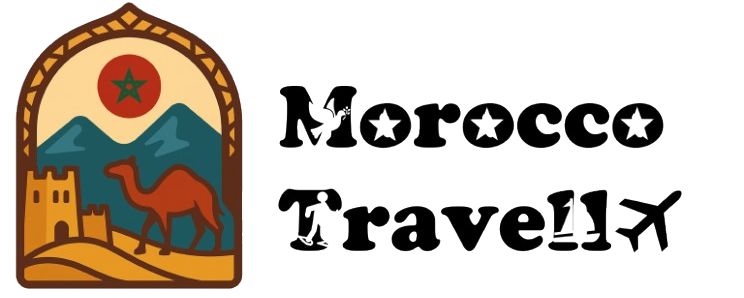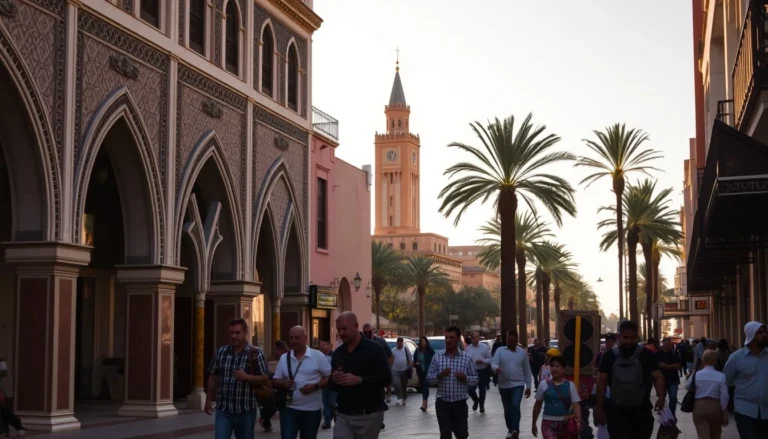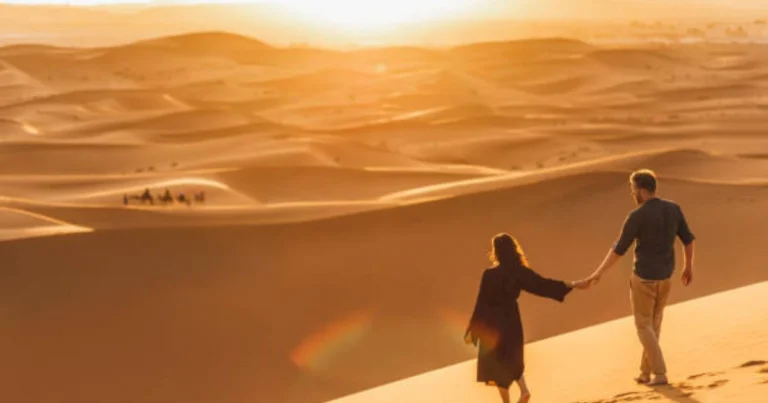The Best Time to Visit Morocco
best time to Visit Morocco
Morocco is a year-round destination, offering a diverse array of experiences for visitors. From the vibrant souks of Marrakech to the serene landscapes of the Sahara Desert, you can explore a world of rich culture and breathtaking natural beauty. Whether you’re looking to immerse yourself in the local culture, relax on the coast, or embark on an adventure, Morocco has something for everyone.
Deciding when to travel to Morocco depends on your itinerary and preferences. The country’s climate varies greatly from north to south, and the activities you have planned will play a significant role in determining the best time for your visit.
Table of Contents
Understanding Morocco’s Climate and Seasons
The climate in Morocco is as diverse as its landscapes, ranging from the mild coastal areas to the hot desert and cold mountains. This diversity significantly impacts the travel experience, making it essential to understand the different climatic conditions across the country.
Diverse Geographic Regions and Their Weather Patterns
Morocco’s geography is characterized by coastal Cities, mountainous areas, and deserts, each with its unique weather patterns. The coastal regions, such as Casablanca and Rabat, experience mild temperatures throughout the year. In contrast, the Atlas Mountains can be quite cold, especially during winter, while the desert regions are known for their extreme heat during the day and cooler temperatures at night.
Overview of the Four Seasons in Morocco
Morocco’s four distinct seasons each offer a unique travel experience.
- Spring (March to May):With comfortable weather and vibrant scenery, it’s an ideal time to discover Morocco.
- Summer (June to August): Hot in the desert and inland, but coastal areas remain pleasant.
- Autumn (September to November): Comfortable temperatures and fewer tourists make it a great time to visit.
- Winter (December to February): Cold in the mountains, mild in coastal areas, and cooler in the desert.
How Climate Affects Your Travel Experience and Itinerary Planning
Understanding Morocco’s climate is crucial for planning your trip. For instance, if you’re planning to visit the Sahara Desert, it’s best to avoid the peak summer months due to the extreme heat. Conversely, if you’re interested in skiing, the Atlas Mountains offer great slopes during winter. The mild climate in coastal cities like Essaouira makes them ideal for visits during any season.
By considering the climate and seasons, you can tailor your itinerary to make the most of your Moroccan adventure, whether you’re exploring the bustling markets of Marrakech in the spring or enjoying the serene beaches of Taghazout in the autumn.
The Best Time to Visit Morocco: Season by Season Breakdown
Morocco’s climate is as diverse as its landscapes, offering a range of experiences across different seasons that cater to various traveler preferences. Understanding the characteristics of each season is crucial for planning your trip to Morocco.
Spring (March-May): Perfect Weather for Exploration
Spring is considered one of the best times to visit Morocco, with mild temperatures and blooming landscapes making it ideal for exploration. The weather is particularly pleasant in the Atlas Mountains and the desert regions, where temperatures are warm during the day and cool at night.
April in Morocco: Why It’s a Prime Month for Visitors
April is a prime month to visit Morocco as the weather is generally mild and pleasant across the country. It’s an excellent time for hiking in the Atlas Mountains or exploring the desert landscapes without the harsh summer heat.
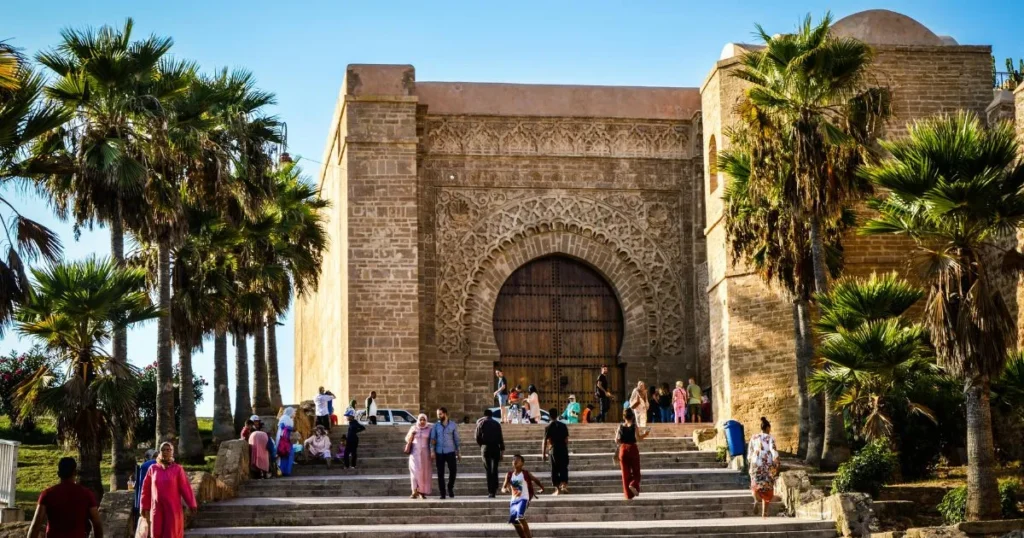
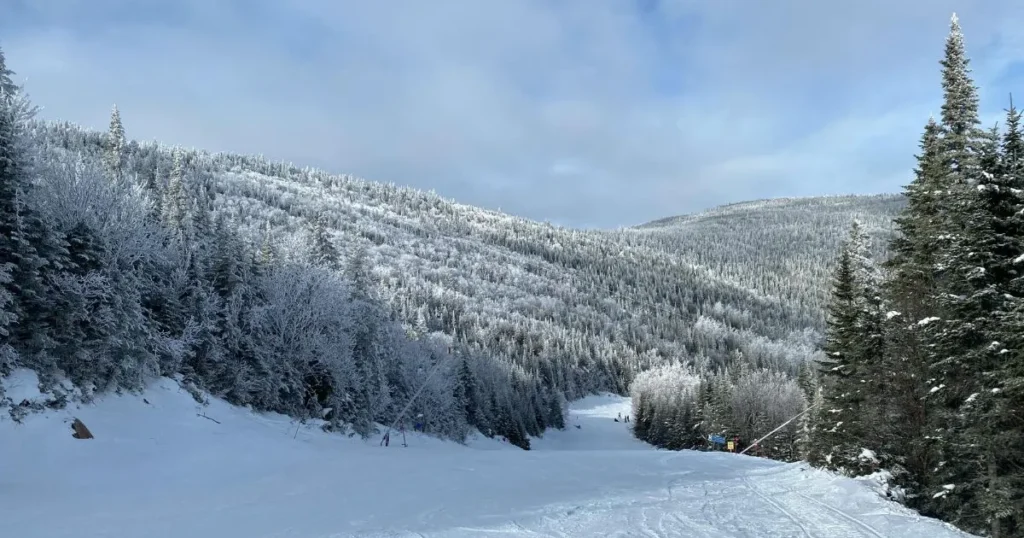
Summer (June-August): Navigating the Heat and Finding Coastal Retreats
Summer in Morocco can be very hot, especially in the desert regions. However, the coastal areas such as Essaouira and Tangier offer cooler temperatures and serve as perfect retreats. Summer is also a great time for festivals and cultural events, making it a vibrant season to experience Morocco’s rich culture.
Autumn (September-November): Ideal Balance of Weather and Crowds
Autumn is another excellent season to visit Morocco, offering a great balance between pleasant weather and fewer crowds compared to the peak summer months. The temperatures are comfortable, making it ideal for exploring Marrakech and other imperial cities.
October in Morocco: The Sweet Spot for Weather and Activities
October is a fantastic time to visit Morocco, with comfortable temperatures and a wide range of activities to enjoy. The weather in October is usually mild, making it perfect for hiking, exploring the souks, or simply enjoying the local cuisine.
Winter (December-February): Mild Coastal Areas and Snow-Capped Mountains
Winter in Morocco brings a different charm to the country, with mild temperatures in the coastal areas and snow-capped peaks in the Atlas Mountains. It’s an excellent time for skiing and snowboarding in the mountains, while the desert regions remain relatively accessible.
Top Destinations and When to Visit Them
As you plan your Moroccan adventure, understanding the best times to visit different regions is crucial. Morocco’s diverse landscapes and climates mean that the ideal visit time varies significantly across destinations.
Marrakech and Fes: Timing Your Visit to Morocco’s Imperial Cities
Marrakech and Fes, Morocco’s imperial cities, are best visited during the spring (March-May) and autumn (September-November). These periods offer pleasant temperatures, making it ideal for exploring the bustling souks and historic landmarks. Avoid visiting during the peak summer months when temperatures soar.
Coastal Escapes: Best Times for Essaouira, Casablanca, and Tangier
The coastal towns of Essaouira, Casablanca, and Tangier offer a more relaxed atmosphere and are great escapes during the hot summer months. Essaouira is particularly pleasant in summer, with its windy conditions making it a haven from the heat. Visit these coastal areas during the spring and autumn for a balanced experience.
| Destination | Best Time to Visit | Highlights |
|---|---|---|
| Marrakech | Spring, Autumn | Explore souks, visit historic landmarks |
| Essaouira | Summer | Relax on beaches, enjoy water sports |
| Sahara Desert | Winter, Spring | Camel trekking, stargazing |
| Atlas Mountains | Spring, Autumn | Hiking, skiing in winter |
Desert Experiences: Planning Your Sahara Adventure by Season
The Sahara Desert is a must-visit destination in Morocco. The best times for a Sahara adventure are during the winter (December-February) and spring (March-May). These seasons offer more comfortable temperatures for camel trekking and exploring the dunes.
Mountain Regions: Seasonal Guide to the Atlas Mountains
The Atlas Mountains are perfect for hiking and trekking during the spring and autumn. Winter months bring snow, making it ideal for skiing. The region’s diverse landscapes and climates offer a range of activities across the seasons.
Cultural Festivals and Events: Planning Around Morocco’s Calendar
Morocco is known for its vibrant cultural festivals and events. Plan your visit around these experiences, such as the Marrakech International Film Festival or the Essaouira Gnawa Music Festival. These events offer a unique glimpse into Moroccan culture and are a great way to engage with the local community.
By understanding the best times to visit Morocco’s diverse destinations, you can plan a more enjoyable and fulfilling trip. Whether you’re interested in Moroccan food, looking for exciting Morocco tours, or booking Morocco travel packages, timing is everything.
Planning Your Morocco Trip: Practical Considerations
To make the most of your time in Morocco, it’s essential to consider a few practical aspects. Planning ahead can significantly enhance your travel experience, ensuring that you enjoy the rich cultural heritage, stunning landscapes, and warm hospitality that Morocco has to offer.
Selecting and Booking Morocco Tours and Travel Packages by Season
When planning your trip to Morocco, selecting the right tour or travel package can be crucial. The season you choose to visit can significantly impact your experience. For instance, spring (March to May) is ideal for exploring the Atlas Mountains and enjoying the blooming flora. Summer (June to August) is perfect for coastal retreats, while autumn (September to November) offers a comfortable climate for desert adventures. Winter (December to February) is great for experiencing the Sahara Desert’s serene landscapes.
Consider booking a package that includes guided tours to make the most of your visit. Many tour operators offer seasonal packages that cater to the specific activities and experiences available during different times of the year. For example, a spring package might include hiking tours in the Atlas Mountains, while a summer package could focus on coastal activities like surfing or relaxing in Essaouira.
Tips for Booking:
- Research tour operators that offer seasonal packages.
- Read reviews and check the itinerary to ensure it matches your interests.
- Book in advance to secure your spot, especially during peak travel seasons.
Seasonal Packing Guide: What to Bring for Each Time of Year
Packing appropriately for your Morocco trip is vital, as the climate varies significantly across different regions and seasons. Here’s a breakdown of what to bring for each season:
| Season | Weather | Essentials to Pack |
|---|---|---|
| Spring | Mild temperatures, occasional rain | Light layers, waterproof jacket, comfortable shoes |
| Summer | Hot, especially inland | Light, breathable clothing, sun hat, sunscreen |
| Autumn | Comfortable temperatures, cooler mornings and evenings | Layers for temperature changes, comfortable walking shoes |
| Winter | Cool to cold, especially in the mountains | Warm clothing, including a coat, gloves, and hat for mountain regions |
Remember, the mountain regions can be quite cold, even in spring and autumn, so it’s always a good idea to pack layers.
Navigating Ramadan and Religious Holidays During Your Visit
Morocco is a Muslim country, and respecting local customs, especially during Ramadan, is crucial. During this holy month, many restaurants are closed during the day, and it’s considered polite to refrain from eating, drinking, or smoking in public during daylight hours.
To navigate Ramadan effectively:
- Plan your meals around iftar and suhoor (the meal before dawn).
- Be respectful of fasting locals by avoiding public consumption of food and drink.
- Enjoy the vibrant atmosphere in the evenings, with many cities hosting special events and festivities.
Seasonal Moroccan Food Specialties to Try During Your Stay
Moroccan cuisine is renowned for its rich flavors and diverse dishes, many of which are seasonal. During your visit, be sure to try some of the local specialties:
- Spring: Fresh salads, grilled lamb, and early harvest olive oil.
- Summer: Refreshing dishes like harira (a hearty soup), cold soups, and an abundance of fresh fruits.
- Autumn: Hearty tagines with preserved lemons and olives, and a variety of squashes.
- Winter: Warm, comforting dishes like lamb tagine with prunes, and rich pastries.
Trying local food is an integral part of the Moroccan experience. Be adventurous and enjoy the seasonal specialties that Morocco has to offer.
Conclusion: Making the Most of Your Moroccan Adventure
With its diverse climates and rich cultural calendar, Morocco offers something unique throughout the year. Whether you’re looking for pleasant spring weather, a vibrant summer festival, or a serene winter escape, Morocco has a season that’s perfect for you.
When planning your trip, consider the best time to visit Morocco based on your preferences. If you’re interested in exploring the imperial cities, spring and autumn are ideal. For a coastal retreat, summer is a great time to enjoy the beaches. If you’re looking for a desert adventure, winter is a good option, with mild temperatures in the Sahara.
To make the most of your Moroccan adventure, consider booking Morocco tours that align with your interests. With a wide range of travel packages available, you can experience the best of Morocco, from its bustling cities to its serene landscapes. By choosing the right time to visit and planning your itinerary accordingly, you’ll be able to enjoy a memorable and enriching experience in this captivating country.
